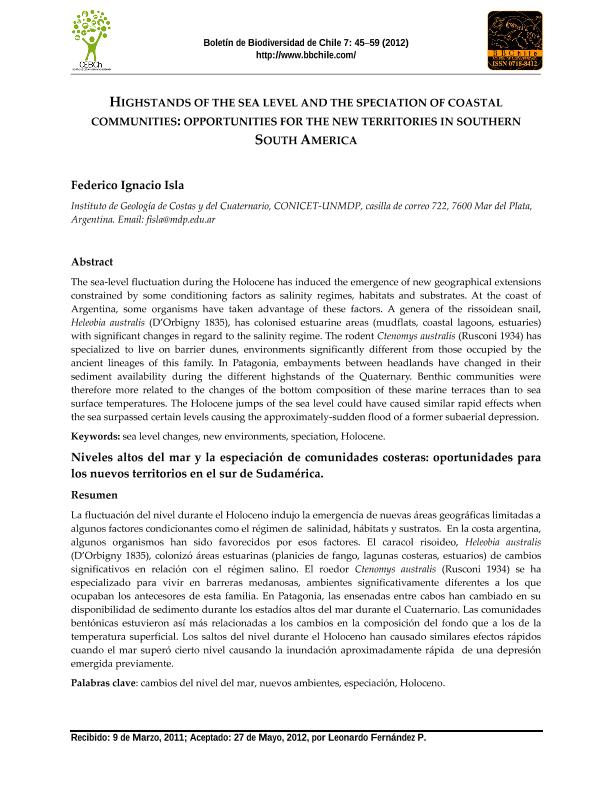Mostrar el registro sencillo del ítem
dc.contributor.author
Isla, Federico Ignacio

dc.date.available
2019-04-09T16:10:57Z
dc.date.issued
2012-09
dc.identifier.citation
Isla, Federico Ignacio; Highstands of the sea level and the speciation of coastal communities: opportunities for the new territories in southern South America; Centro de Estudios de Biodiversidad; Boletin de Biodiversidad de Chile; 7; 9-2012; 48-62
dc.identifier.issn
0718-8412
dc.identifier.uri
http://hdl.handle.net/11336/73561
dc.description.abstract
La fluctuación del nivel durante el Holoceno indujo la emergencia de nuevas áreas geográficas limitadas a algunos factores condicionantes como el régimen de salinidad, hábitats y sustratos. En la costa argentina, algunos organismos han sido favorecidos por esos factores. El caracol risoideo, Heleobia australis (D’Orbigny 1835), colonizó {reas estuarinas (planicies de fango, lagunas costeras, estuarios) de cambios significativos en relación con el régimen salino. El roedor Ctenomys australis (Rusconi 1934) se ha especializado para vivir en barreras medanosas, ambientes significativamente diferentes a los que ocupaban los antecesores de esta familia. En Patagonia, las ensenadas entre cabos han cambiado en su disponibilidad de sedimento durante los estadíos altos del mar durante el Cuaternario. Las comunidades bentónicas estuvieron así más relacionadas a los cambios en la composición del fondo que a los de la temperatura superficial. Los saltos del nivel durante el Holoceno han causado similares efectos rápidos cuando el mar superó cierto nivel causando la inundación aproximadamente rápida de una depresión emergida previamente.
dc.description.abstract
The sea-level fluctuation during the Holocene has induced the emergence of new geographical extensions constrained by some conditioning factors as salinity regimes, habitats and substrates. At the coast of Argentina, some organisms have taken advantage of these factors. A genera of the rissoidean snail, Heleobia australis (D?Orbigny 1835), has colonised estuarine areas (mudflats, coastal lagoons, estuaries) with significant changes in regard to the salinity regime. The rodent Ctenomys australis (Rusconi 1934) has specialized to live on barrier dunes, environments significantly different from those occupied by the ancient lineages of this family. In Patagonia, embayments between headlands have changed in their sediment availability during the different highstands of the Quaternary. Benthic communities were therefore more related to the changes of the bottom composition of these marine terraces than to sea surface temperatures. The Holocene jumps of the sea level could have caused similar rapid effects when the sea surpassed certain levels causing the approximately-sudden flood of a former subaerial depression.
dc.format
application/pdf
dc.language.iso
eng
dc.publisher
Centro de Estudios de Biodiversidad
dc.rights
info:eu-repo/semantics/openAccess
dc.rights.uri
https://creativecommons.org/licenses/by-nc-sa/2.5/ar/
dc.subject
Sea-Level Changes
dc.subject
New Environements
dc.subject
Speciation
dc.subject
Holocene
dc.subject
Cambios del Nivel del Mar
dc.subject
Nuevos Ambientes
dc.subject
Especiación
dc.subject
Holoceno
dc.subject.classification
Otras Ciencias Biológicas

dc.subject.classification
Ciencias Biológicas

dc.subject.classification
CIENCIAS NATURALES Y EXACTAS

dc.subject.classification
Biología Marina, Limnología

dc.subject.classification
Ciencias Biológicas

dc.subject.classification
CIENCIAS NATURALES Y EXACTAS

dc.title
Highstands of the sea level and the speciation of coastal communities: opportunities for the new territories in southern South America
dc.title
Niveles altos del mar y la especiación de comunidades costeras: oportunidades para
los nuevos territorios en el sur de Sudamérica.
dc.type
info:eu-repo/semantics/article
dc.type
info:ar-repo/semantics/artículo
dc.type
info:eu-repo/semantics/publishedVersion
dc.date.updated
2019-03-08T16:44:44Z
dc.journal.volume
7
dc.journal.pagination
48-62
dc.journal.pais
Chile

dc.journal.ciudad
Osorno
dc.description.fil
Fil: Isla, Federico Ignacio. Consejo Nacional de Investigaciones Científicas y Técnicas. Centro Científico Tecnológico Conicet - Mar del Plata. Instituto de Investigaciones Marinas y Costeras. Universidad Nacional de Mar del Plata. Facultad de Ciencias Exactas y Naturales. Instituto de Investigaciones Marinas y Costeras; Argentina
dc.journal.title
Boletin de Biodiversidad de Chile
dc.relation.alternativeid
info:eu-repo/semantics/altIdentifier/url/http://www.bbchile.com/pdfs/2012/7/06-Isla-2012-7.pdf
dc.relation.alternativeid
info:eu-repo/semantics/altIdentifier/url/http://www.bbchile.com/2012/09/
dc.relation.alternativeid
info:eu-repo/semantics/altIdentifier/url/https://dialnet.unirioja.es/servlet/articulo?codigo=5523738
Archivos asociados
